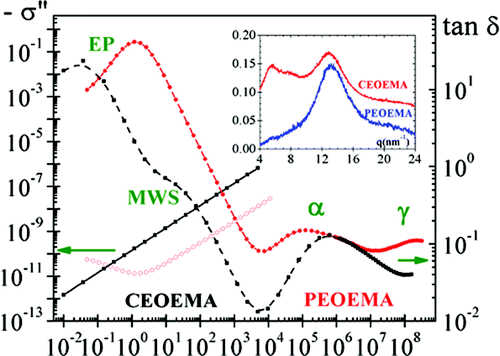The dielectric relaxation spectra of poly(2-ethoxyethyl methacrylate) in the frequency domain exhibits above Tg and at high frequencies a well-developed secondary γ relaxation. This process is followed in decreasing order of frequency for a relatively weak β relaxation and an ostensible glass–rubber relaxation which at high temperatures and low frequencies is dominated by electrode–polymer interfacial processes. By slightly cross-linking the polymer using 2.5% (mol) of 2-ethoxyethyldimethacrylate as cross-linking agent, the β relaxation disappears, the γ relaxation remaining. The activation energy of the γ relaxation for the cross-linked and un-cross-linked polymers is ca. 30 kJ·mol–1, about 10 kJ·mol–1 below that of the β relaxation. Cross-linking shifts the location of the glass–rubber relaxation nearly 10 °C to higher temperatures, without widening the distribution of relaxation times. The X-rays pattern of the cross-linked polymer presents two peaks at q = 5.6 nm–1 and 12.76 nm–1, resembling the X-ray patterns of poly(n-alkyl methacrylate)s. The peaks in poly(n-alkyl methacrylate)s were attributed to the formation of nanodomains integrated by side chains flanked by the backbone. However, whereas this heterogeneity produces an αPE peak in poly(n-alkyl methacrylate)s with n ≥ 2, this microheterogeneity gives rise to a Maxwell–Wagner–Sillars (MWS) relaxation in the cross-linked polymer located at lower frequencies than the glass rubber relaxation. Finally the interfacial-electrode conductive processes of the cross-linked and un-cross-linked polymeric systems are studied in the light of current theories.







